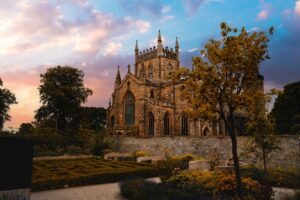In the heart of Dunfermline stands Dunfermline Abbey, one of Scotland’s most important historic landmarks. The Abbey is not only a striking place of worship but also a Royal Mausoleum, where generations of monarchs, including King Robert the Bruce, were laid to rest.
Blending medieval ruins with later church architecture, the Abbey offers a window into Scotland’s royal and religious story. Easily reached from Edinburgh or Glasgow, it is a must-visit for anyone exploring Fife and central Scotland.
The story of Dunfermline Abbey begins in the 11th century, when Queen Margaret, later canonised as St Margaret, invited Benedictine monks from Canterbury to establish a priory here. Her husband, King Malcolm III, made Dunfermline his royal seat, securing the town’s place in Scotland’s history.
Their son, David I, elevated the priory to full abbey status in 1128. Over the following centuries, Dunfermline became one of the country’s most influential religious centres, rivalling Iona and St Andrews.
Although much of the Abbey was damaged during the Wars of Independence, King Robert the Bruce ordered its rebuilding. After the Reformation of 1560, many monastic buildings fell into ruin, yet the Romanesque nave survived and remains a centre of worship to this day.
Dunfermline Abbey is often described as Scotland’s Westminster Abbey for its royal burials. Kings and queens buried here include Malcolm III, Queen Margaret, David I, and Alexander III. The most famous is Robert the Bruce, whose tomb lies beneath the parish church, marked by a tower proudly inscribed with his name.
St Margaret’s influence is particularly significant. Remembered for her piety and acts of charity, she shaped Scotland’s medieval church, and her legacy remains one of the Abbey’s enduring stories.
Today, Dunfermline Abbey is managed by Historic Environment Scotland. While much of the medieval Abbey is in ruins, the nave remains in use as a parish church and is open to visitors. Information boards help bring the site’s long history to life, and the surrounding grounds provide a peaceful setting for reflection.
The Abbey can be combined with other nearby attractions, including Pittencrieff Park, the Andrew Carnegie Birthplace Museum, and the shops and cafés of Dunfermline’s historic town centre.
Address: St Margaret Street, Dunfermline, KY12 7PE
Dunfermline Abbey is more than a historic ruin—it is a living chronicle of Scotland’s royal and spiritual heritage. From the tomb of Robert the Bruce to the legacy of St Margaret, its stones carry the weight of centuries.
Whether you are tracing Scotland’s kings, enjoying a day trip from Edinburgh, or exploring the wider Fife region, Dunfermline Abbey is a destination that should not be missed.

Who is buried at Dunfermline Abbey?
Monarchs, including Malcolm III, Queen Margaret, David I, and King Robert the Bruce, are buried at the Abbey.
What is the cost to visit the Abbey?
Admission to the Abbey is free, although donations are welcome.
Is Dunfermline Abbey still in use?
Yes, the nave continues to serve as a parish church, while the ruins are open to visitors.
What else can I see nearby?
Pittencrieff Park, the Andrew Carnegie Birthplace Museum, and Dunfermline Palace are all worth visiting.
How do I get to Dunfermline Abbey from Edinburgh?
The Abbey can be reached by car via the M90 or by train from Edinburgh Waverley Station, leaving a short walk from Dunfermline station.